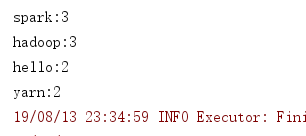(1)基于排序机制的wordcount程序
对于以下文件

进行wordcount,并按照出现次数多少排序
代码如下:
/**
* 排序的wordcount程序
* @author Administrator
*
*/
public class SortWordCount {
public static void main(String[] args) {
SparkConf conf=new SparkConf().setAppName("SortWordCount").setMaster("local");
JavaSparkContext sparkContext=new JavaSparkContext(conf);
sparkContext.textFile("D://Bigdata//18.spark//wc.txt")
.flatMap(new FlatMapFunction<String, String>() {
@Override
public Iterator<String> call(String s) throws Exception {
return new Arrays.Iterator<>(s.split(" "));
}
}).mapToPair(new PairFunction<String, String, Integer>() {
@Override
public Tuple2<String, Integer> call(String s) throws Exception {
return new Tuple2<String,Integer>(s,1);
}
}).reduceByKey(new Function2<Integer, Integer, Integer>() {
@Override
public Integer call(Integer integer, Integer integer2) throws Exception {
return integer+integer2;
}
}).mapToPair(new PairFunction<Tuple2<String, Integer>, Integer, String>() {
@Override
public Tuple2<Integer, String> call(Tuple2<String, Integer> s) throws Exception {
return new Tuple2<Integer, String>(s._2,s._1);
}
}).sortByKey(false).mapToPair(new PairFunction<Tuple2<Integer, String>, String, Integer>() {
@Override
public Tuple2<String, Integer> call(Tuple2<Integer, String> s) throws Exception {
return new Tuple2<String, Integer>(s._2,s._1);
}
}).foreach(new VoidFunction<Tuple2<String, Integer>>() {
@Override
public void call(Tuple2<String, Integer> s) throws Exception {
System.out.println(s._1+":"+s._2);
}
});
}
}
结果如下:

(2)二次排序
对于以下文件内容
1 5
2 4
3 6
1 3
2 1
要想得到以下结果

可以通过以下代码
import scala.math.Ordered;
import java.io.Serializable;
public class SecondarySortKey implements Ordered<SecondarySortKey>, Serializable {
private static final long serialVersionUID = -2366006422945129991L;
// 首先在自定义key里面,定义需要进行排序的列
private int first;
private int second;
public SecondarySortKey(int first, int second) {
this.first = first;
this.second = second;
}
public int getFirst() {
return first;
}
public void setFirst(int first) {
this.first = first;
}
public int getSecond() {
return second;
}
public void setSecond(int second) {
this.second = second;
}
@Override
public int compare(SecondarySortKey that) {
return 0;
}
@Override
public boolean $less(SecondarySortKey that) {
if (this.first<that.getFirst()){
return true;
}else if (this.first==that.getFirst()){
return true;
}
return false;
}
@Override
public boolean $greater(SecondarySortKey other) {
if (this.first>other.getFirst()){
return true;
}else if (this.first==other.getFirst()&&this.second>other.getSecond()){
return true;
}
return false;
}
@Override
public boolean $less$eq(SecondarySortKey that) {
if(this.$less(that)) {
return true;
} else if(this.first == that.getFirst() &&
this.second == that.getSecond()) {
return true;
}
return false;
}
@Override
public boolean $greater$eq(SecondarySortKey that) {
if (this.$greater(that)){
return true;
}else if (this.first==that.getFirst()&&this.second== that.getSecond()){
return true;
}
return false;
}
@Override
public int compareTo(SecondarySortKey that) {
if (this.first-that.getFirst()!=0){
return this.first-that.getFirst();
}else {
return this.second-that.getSecond();
}
}
import org.apache.spark.SparkConf;
import org.apache.spark.api.java.JavaPairRDD;
import org.apache.spark.api.java.JavaRDD;
import org.apache.spark.api.java.JavaSparkContext;
import org.apache.spark.api.java.function.Function;
import org.apache.spark.api.java.function.PairFunction;
import org.apache.spark.api.java.function.VoidFunction;
import scala.Tuple2;
/**
* 二次排序
* 1、实现自定义的key,要实现Ordered接口和Serializable接口,在key中实现自己对多个列的排序算法
* 2、将包含文本的RDD,映射成key为自定义key,value为文本的JavaPairRDD
* 3、使用sortByKey算子按照自定义的key进行排序
* 4、再次映射,剔除自定义的key,只保留文本行
* @author Administrator
*
*/
public class SecondarySort {
public static void main(String[] args) {
SparkConf conf=new SparkConf().setAppName("SortWordCount").setMaster("local");
JavaSparkContext sparkContext=new JavaSparkContext(conf);
JavaRDD<String> lines=sparkContext.textFile("D:\\BaiduYunDownload\\Spark课件\\第39讲-Spark核心编程:高级编程之二次排序\\文档\\sort.txt");
JavaPairRDD<SecondarySortKey,String> pairRDD=lines.mapToPair(new PairFunction<String, SecondarySortKey, String>() {
@Override
public Tuple2<SecondarySortKey, String> call(String s) throws Exception {
String[] strings=s.split(" ");
SecondarySortKey secondarySortKey=new SecondarySortKey(Integer.valueOf(strings[0]),Integer.valueOf(strings[1]));
return new Tuple2<>(secondarySortKey,s);
}
});
JavaPairRDD<SecondarySortKey,String> sortPairRDD=pairRDD.sortByKey(false);
JavaRDD<String> resultRDD=sortPairRDD.map(new Function<Tuple2<SecondarySortKey, String>, String>() {
@Override
public String call(Tuple2<SecondarySortKey, String> s) throws Exception {
return s._2;
}
});
resultRDD.foreach(new VoidFunction<String>() {
@Override
public void call(String s) throws Exception {
System.out.println(s);
}
});
}
}
(3)topn
1、对文本文件内的数字,取最大的前3个。
import org.apache.spark.SparkConf;
import org.apache.spark.api.java.JavaPairRDD;
import org.apache.spark.api.java.JavaRDD;
import org.apache.spark.api.java.JavaSparkContext;
import org.apache.spark.api.java.function.Function;
import org.apache.spark.api.java.function.PairFunction;
import scala.Tuple2;
import java.util.Iterator;
import java.util.List;
public class Top3 {
public static void main(String[] args) {
SparkConf conf = new SparkConf()
.setAppName("Top3")
.setMaster("local");
JavaSparkContext sc = new JavaSparkContext(conf);
JavaRDD<String> lines = sc.textFile("D:\\BaiduYunDownload\\top.txt");
JavaPairRDD<Integer,String> pairs=lines.mapToPair(new PairFunction<String, Integer, String>() {
@Override
public Tuple2<Integer, String> call(String s) throws Exception {
return new Tuple2<Integer, String>(Integer.valueOf(s),s);
}
});
JavaPairRDD<Integer,String> sortPairs=pairs.sortByKey(false);
JavaRDD<String> sortList=sortPairs.map(new Function<Tuple2<Integer, String>, String>() {
@Override
public String call(Tuple2<Integer, String> s) throws Exception {
return s._2;
}
});
List<String> list=sortList.top(3);
Iterator<String> it=list.iterator();
while (it.hasNext()){
System.out.println(it.next());
}
}
}
2、对每个班级内的学生成绩,取出前3名。(分组取topn)
3、课后作用:用Scala来实现分组取topn。